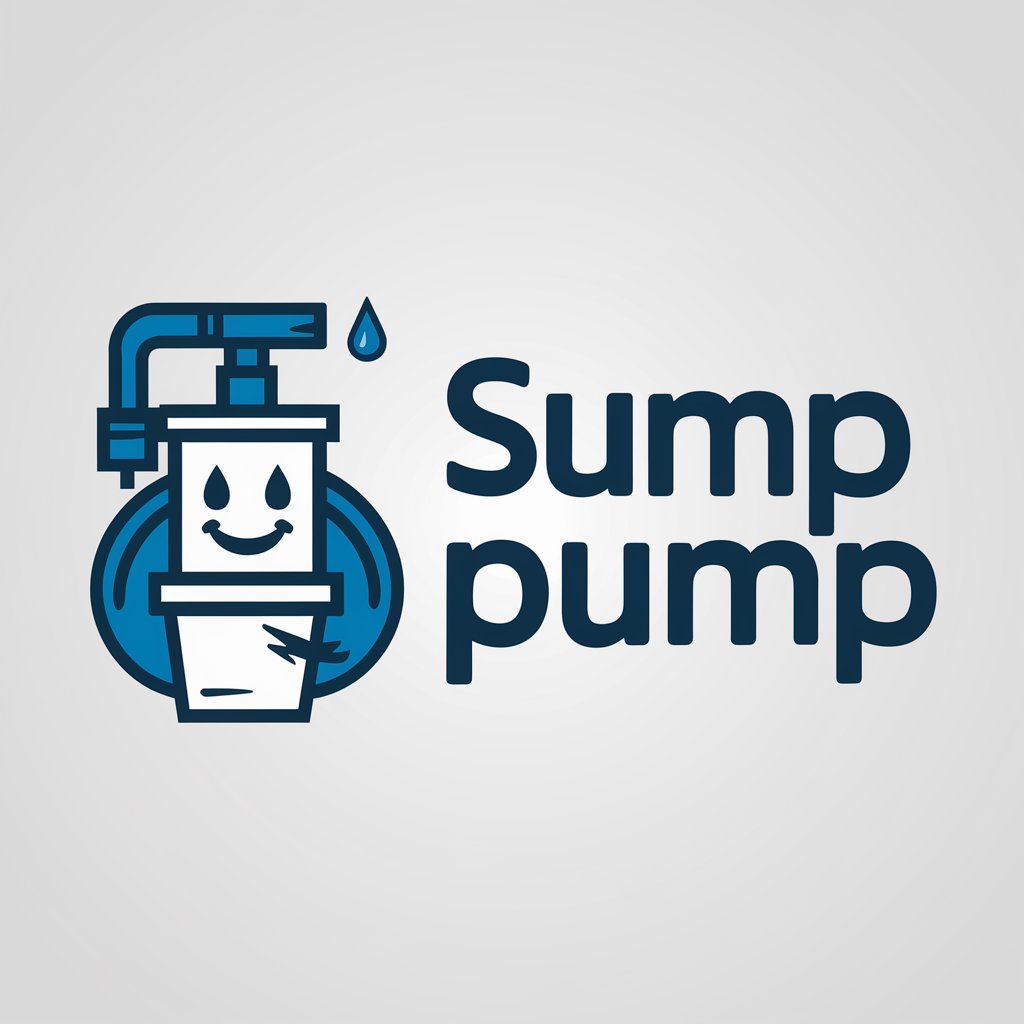Sump Pump - Sump Pump Insight

Hello! Let's dive into everything about sump pumps!
Empower your home with AI-driven water management.
How does a sump pump work and what are its main components?
What are the different types of sump pumps and their pros and cons?
How can I install a sump pump in my basement?
What are some common sump pump issues and how can I troubleshoot them?
Get Embed Code
Understanding Sump Pumps: Purpose and Design
A sump pump is a crucial device installed in the lowest part of a basement or crawlspace, designed to prevent water accumulation and protect properties from water damage. Its primary purpose is to pump water out of the sump basin and away from the building, thus preventing basement flooding, mold growth, and foundation damage. Sump pumps are especially vital in areas prone to heavy rainfall or where the water table is high. They come in various types, including submersible pumps, which sit inside the sump pit and are designed to work underwater, and pedestal pumps, which have a motor mounted above the sump, preventing it from getting wet. An example scenario illustrating its importance is during a heavy rainstorm; the sump pump activates automatically when the water level in the sump pit rises, pumping out the excess water and directing it away from the home's foundation, thereby preventing potential flooding and water damage. Powered by ChatGPT-4o。

Key Functions of Sump Pumps
Water Removal
Example
Preventing basement flooding during storms
Scenario
During heavy rainfall, the sump pump automatically turns on when the water level in the sump basin reaches a certain height, efficiently removing water from the basement and discharging it away from the home's foundation.
Mitigating Mold and Mildew Growth
Example
Maintaining a dry basement environment
Scenario
By keeping the basement or crawlspace dry, sump pumps reduce the humidity levels, which in turn prevents the growth of mold and mildew that can cause health issues and damage to home materials.
Foundation Protection
Example
Safeguarding the structural integrity of a home
Scenario
Continuous water accumulation around the foundation can lead to structural weakening. Sump pumps maintain a dry foundation by removing excess water, thereby preventing costly damages.
Who Benefits from Sump Pumps?
Homeowners in Flood-Prone Areas
Individuals living in areas susceptible to heavy rainfall or near water bodies greatly benefit from sump pumps by preventing water from flooding their basements, thus protecting their property and investments.
Property Owners with Basements or Crawlspaces
Owners of properties with basements or crawlspaces are ideal users, as these are areas where water is likely to accumulate. A sump pump is essential for maintaining the structural integrity and health of these spaces.
DIY Enthusiasts and Home Improvement Aficionados
Those interested in home maintenance and improvements can benefit from understanding and possibly installing sump pumps themselves, ensuring their property remains dry and free from water-related issues.

How to Use Sump Pump
1
Initiate your exploration by registering for a complimentary trial at yeschat.ai, requiring no sign-in or subscription to ChatGPT Plus.
2
Identify your specific need or problem area related to water management in basements or crawl spaces to determine the appropriate sump pump model.
3
Install the sump pump according to the manufacturer's instructions, ensuring it is correctly placed in the sump pit with a proper power source and drainage system.
4
Regularly test the sump pump by pouring water into the pit until the pump activates, ensuring it operates effectively and the discharge line is clear.
5
Perform routine maintenance, such as cleaning the sump pit, checking the battery backup, and inspecting for wear and tear, to prolong the life of the pump and ensure optimal performance.
Try other advanced and practical GPTs
不惑禅师
Guiding Your Path to Enlightenment

Offer Insight GPT
Craft Compelling Offers with AI Insight

FitFuel
Tailored Nutritional Guidance at Your Fingertips

TRPG Master
Empowering your adventures with AI

Wedding Wisher
Crafting Heartfelt AI-Powered Wedding Wishes

志望動機作成くん(Web・アイミツ)
AI-Powered, Custom Intent Statements

Ski Mountain
Elevate Your Slope Skills with AI

Mentor Marc Bot
Empowering growth with AI-driven EOS insights

Data Insight
Empowering insights with AI-driven analysis

Special Education
Empowering Education with AI

Scholar's Mate
Empowering research with AI

MinimalisticGPT
Simplicity meets intelligence

Sump Pump Q&A
What is a sump pump and why do I need one?
A sump pump is a device used to remove accumulated water from a sump basin, commonly found in the basements of homes. It's essential for preventing water damage, mold growth, and foundation issues in areas prone to flooding or with high groundwater levels.
How do I choose the right sump pump for my home?
Selecting the right sump pump depends on several factors, including the size of your basement or crawl space, the amount of water to be managed, and whether you need a primary, battery backup, or combination sump pump. Consulting with a professional can help determine the best fit for your needs.
Can I install a sump pump myself?
Yes, with basic plumbing knowledge and the right tools, many homeowners can install a pedestal or submersible sump pump. However, for complex installations or where a new sump pit needs to be created, professional installation is recommended.
How often should I maintain my sump pump?
Routine maintenance should be performed at least once a year, but checking it more frequently, especially before the rainy season, is advisable to ensure it's in good working condition.
What common issues might I encounter with a sump pump, and how can I troubleshoot them?
Common issues include the pump not turning on, running continuously, or not removing water efficiently. Troubleshooting steps include checking for power supply issues, ensuring the float switch is not obstructed, and verifying that the discharge line is clear and free of clogs.
